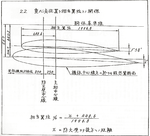The tricky question are:
- type/series of wing profile used (claimed to be of laminar flow)
- wing thickness-to-chord ratio?
Some data can be accesed via convoluted channels, like this pic attached. The wing profile details might be the two rows I've marked with joint red '?'.

- type/series of wing profile used (claimed to be of laminar flow)
- wing thickness-to-chord ratio?
Some data can be accesed via convoluted channels, like this pic attached. The wing profile details might be the two rows I've marked with joint red '?'.

